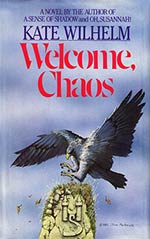
![]() couchtomoon
couchtomoon
4/26/2015
![]()
Two parts mainstream Cold War espionage thriller to one part bio-social science fiction, Welcome, Chaos is a departure from Wilhelm's reflective, elegiac vision of seven years prior: the captivating, multiple award-winning Where Late the Sweet Birds Sang (1976). In many ways common with one another, both novels contain themes of pre- to post-apocalypse, survival via artificial biological advancements, ethics of scientific intervention, and, well, birds.
When Lyle Taney leaves her history professorship to study nesting eagles on the coast of Oregon, she finds herself torn between befriending her warm, intelligent neighbor Mr. Werther, and spying on him for arrogant CIA agent Lasater. She doesn't trust the domineering CIA agent, and she's both intrigued and attracted to Werther, and his house servant Carmen. Are these men really responsible for the deaths of two scientists?
Between both novels, Wilhelm seems to be saying that it will require an apocalypse to put power into the hands of scientists, but she's uncertain if this is a good thing. WhereSweet Birds serves as an ethical quandary, emanating a suspicion of scientists with bountiful resources, power, and entitlement, Welcome, Chaos conveys an optimism about similar circumstances, where scientists stand poised to serve humanity at the edge of nuclear annihilation. Both narratives are motivated by ethical questions, but, unlikeSweet Birds, Welcome, Chaosfails to provoke any serious and prolonged contemplation.
The difference lies in the treatment of the protagonists. In Sweet Birds, the protagonists are symbolic of every person; the reader sees humanity at the core of the tale. That micro-story about a small, intimate post-apocalyptic community feels grander, all-encompassing. The tension affects us. This could be us. Alternately, the protagonist in Chaos is one woman, one damn lucky woman, who stumbles into an unlikely situation, is likeable enough to be welcomed and supported in said situation, is loved by multiple men, and who ultimately aids in the survival of humanity.
But the overarching theme is essentially about big decisions about life, love, survival, and, primarily, the female self. Taney, initially a doormat by modern standards, develops to become a more modern woman. The text, feminist from the get-go with Lasaster's relentless blasts of condescension, ("Maternal devotion, security, money, revenge, that was what [women] understood" [20]), makes it obvious that Taney will choose to defy Lasater and abandon her meek life.
But overall, major parts of the narrative are hard to swallow. Lasater locates Werther's Pennsylvania hideout by simply driving around the entire Delaware Valley region. He plays cat-and-mouse with Taney all over the East coast and finds her in a highway traffic jam during a blizzard. I can't even find my grandma in the local, rural mall on a weekday morning.But that's part of what keeps this novel from being just a generic grocery store thriller. Over thirty years before Ancillary Justice, Kate Wilhelm plays with language degenderification by gender swapping character names, like Lyle, Carmen, Hilary. Even [Lass]ater is an appellative joke, as the vain, needy detective demonstrates his inability to drive. She takes gender relations further, introducing Taney to a household of scientists with open romantic relationships, but without sexualizing anyone. When Taney's physical appearance is complimented, she is full-cheeked, bright-eyed, with soft hair. Her multiple men love her for who she is. In dangerous situations, Wilhelm's slight hints at rape tension are oddly and abruptly abandoned--perhaps as a statement on this tired plotting cliché.
Also, common in thriller fiction is the large cast of (assumed to be) white men as law enforcement and elected officials. Some scenes act as 'who's who', only to become 'who the hell is who'? Really more of flaw with this particular subgenre, than a criticism of Wilhelm, but difficult to follow, nonetheless. Also, those ethical questions that are primarily posed to drive tension fail to do so, and the only real tension revolves around the true identities and motivations of Werther and Carmen--interesting, yes, but are resolved by the middle of the novel. The rest of the novel serves as playground for Taney's risk-taking, but her evolution as a strong, independent woman is complete by then. We believe in her, so there's no real reason to worry.
Just looking at Wilhelm's bibliography, it's apparent that her body of work has changed over time, with her psychological sci-fi giving way to mystery fiction. Welcome, Chaos serves as a clear transition of Wilhelm's interests in this regard, where the serious treatment of scientific advancement takes a backseat to detective chases and scientific scheming. Given Wilhelm's vocal frustration at the publishing industry, this may be a financial decision for this award-winning and celebrated author. But this is no Sweet Birds.
So maybe Welcome, Chaos does read like a novel from a grocery store shelf, but it's top shelf grocery store fiction because Wilhelm knows what she's doing in this format, she does it well, and she doesn't cater to formula or cliché. Generic flavor, but with natural ingredients, it's not satisfying in the sense that it will thrill or provoke, but it does compel page-turning. Wilhelm's Taney is a unique female voice, it's fun to watch her grow, and the arc unfolds in an unusual way. Categorize this one as a mainstream follow up that straddles subgenres, while being alternately dubious and unputdownable.
http://couchtomoon.wordpress.com